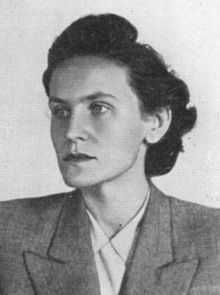Ilse Stöbe
Ilse Stöbe (17 May 1911 Berlin - 22 December 1942 Berlin) was a German journalist and anti-Nazi resistance fighter.

Ilse Stöbe grew up in a working class home in Berlin. After school, she was first employed in the publishing house of Rudolf Mosse and then as secretary to the journalist Theodor Wolff in the Berliner Tageblatt. There she met Rudolf Herrnstadt, to whom she later became engaged. Together, they went early in 1934 to Warsaw, where she worked as a foreign correspondent. Stöbe was then a member of the National Socialist German Workers Party (Nazi Party) and in mid-1934 was appointed Cultural Attaché of the Nazi party's foreign office in Poland.
Just before the start of the Second World War, she returned to Berlin and worked in the Information Department of the Foreign Office. With her brother Kurt, Ilse soon resumed contact with politically minded groups in the fight against the Nazi regime. She kept constant contact with her childhood friend Helmut Kindler. During the Olympic Games in Berlin in 1936 Ilse met the Swiss publisher Rudolf Huber, who left her most of his fortune in his will when he died in 1940. In autumn 1939 she met Carl Helfrich, with whom she lived until her arrest in an apartment in Berlin.
She was arrested on 12 September 1942 by the Gestapo, allegedly for spying for the Soviet Union and for membership of the Red Orchestra (Die Rote Kapelle) Soviet espionage ring. A Gestapo report of November 1942 said a radio message from the Soviet Union informed that a parachuted resistance fighter would come to her address. Under torture she was compelled to confess to conspiratorial connections to the Soviet secret service and to persons such as Rudolf von Scheliha. He was then also arrested in October 1942. Both were sentenced to death for treason on 14 December 1942 by the Reich Military Court, and executed on 22 December 1942 in the Plötzensee Prison in Berlin, Stöbe by guillotine and Scheliha by hanging from a meathook. The Soviet agent, Heinrich Koenen, who had landed in Germany by parachute, was arrested at her house by a waiting Gestapo official.
Her mother was also arrested and sent to Ravensbrück concentration camp, where she died in 1943. Stöbe's brother Kurt Müller was able to escape arrest and continue his resistance activities with the resistance group, the European Union Resistance. He was murdered in June 1944.
Stöbe (code name "Alta") repeatedly sent warning messages to the Soviet Union about the impending German invasion of the Soviet Union well in advance of the attack.[1]
She was the only woman to be featured on a special coin issued by the East German Ministry of State (Stasi) to commemorate important spies in Communist service during the war. The Ilse Stöbe Vocational School in Market Street, Berlin is named in her honour.
In July, 2014, Germany's Foreign Ministry honoured Ilse Stoebe for her actions against the Nazis.[2]
References
- Kegel, Gerhard. In the storms of the century: a German Communist about his unusual life Berlin: Dietz Verlag, 1984. ISBN 3-320-00609-6
- Kindler, Helmut. To leave one party: the autobiography of a German publisher Munich: Droemer Knaur, 1992. ISBN 3-426-75042-2
- Kraushaar, Luise, et al., editors. German resistance fighters 1933–1945: Biographies and letters Berlin: Dietz Verlag, 1970. Volume 1 page 657ff, Volume 2 page 561f
- Kraushaar, Luise. Berlin Communists in the fight against fascism from 1936 to 1942: Robert Uhrig and his comrades Berlin : Dietz Verlag, 1980
- Liebmann, Irina. Was it nice? It was nice! My father Rudolf Herrnstadt Berlin: Verlag Berlin, 2008. ISBN 3-8270-0589-2
- Rosiejka, Gert. The Red Orchestra. "Treason" as an anti-fascist resistance Hamburg, Ergebnisse Verlag, 1986. ISBN 3-925622-16-0. Pages 49–51
- Sahm, Ulrich. "Ilse Stöbe". In Coppi, Hans; Danyel, Jürgen; Tuchel, John (eds), The Red Orchestra in the resistance against National Socialism: Writings of the German Resistance Memorial Berlin: 1994. Pages 262–276
|